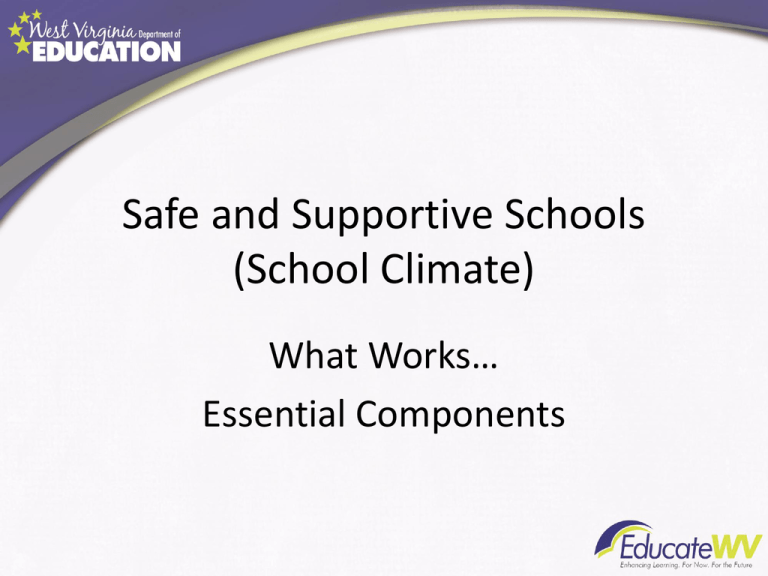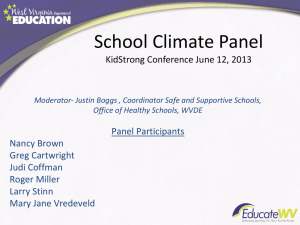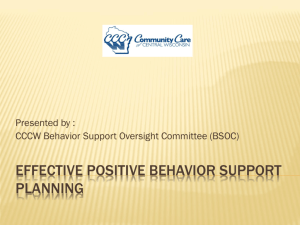Safe and Supportive Schools (School Climate) What Works… Essential Components
advertisement

Safe and Supportive Schools (School Climate) What Works… Essential Components Culture v. Climate • Culture refers to the behavioral norms, assumptions and beliefs of a school -A School’s Personality • Climate refers to perceptions of persons in the school that reflect those norms, assumptions and beliefs. -A School’s Mood Leadership Team • Decide on and recruit members (training?) • Schedule meetings/time to meet • Assign roles: agenda, student & dashboard data, minutes, communicating with staff • Establish a fixed agenda: e.g., analyze behavior and other data, review action plan review budget (how much left to spend) • Create effective in-school communication system • Anticipate threats to team effectiveness • Be CHEERLEADERS! WHY a Team? Cooperative planning Whole staff initiative (not top-down, not bottom-up… represents entire staff) Shared responsibility for implementing initiatives On-going management and support Leadership Team Issues • • • • • Member burn out Turn over (teacher/staff and administrator Some carrying all the weight Removal of a member Dynamics of team members Discipline Matrix Example Staff Buy-In On All Components • • • • • • • • • • Must understand the WHY of improving climate Staff meeting to go over draft plan Share copy of draft plan Panel presentation by team members Staff input into steps for achieving goals Ask for help, e.g., team for each goal Person to person convincing of fence-sitters Share data of progress to win over skeptics Recognize, celebrate successes Food and T-shirts Staff Buy-In On All Components • • • • • • • • • Staff meeting to go over plan Share copy of plan Panel presentation by team members Staff input into plans for achieving goals Ask for help, e.g., team for each goal Person to person convincing of fence-sitters Share data of progress to win over skeptics Recognize, celebrate successes Food and T-shirts Establish Staff Norms Identify staff norms that contribute to a positive school climate and reinforce, reward, and hold each other accountable for those behaviors. For example: high expectations for all students positive approaches to discipline no display of anger or sarcasm model respectful behavior no bullying or harassment Agree on hallway behaviors that invite relationships, e.g. smiling, making eye contact, using students’ names, greeting students at the classroom door before and after class. Safe and Supportive Schools Activity Data Analyzed Regularly • School Climate Survey analyzed annually and reviewed periodically • SWOT, Environmental Scan • Behavior Data reviewed at each team meeting (frequent referrals – students, behaviors) • Dashboard Data analyzed for patterns • Attendance, Graduation Rate, etc. • Evaluation… did we get the results we wanted? Data, Not Hunches! – Don’t Make Assumptions! Behavior Expectations Clear to All • • • • What are they and what do they mean? Communicate to staff and clarify Present and explain to students (stress priorities) Teach -- don’t assume! – and re-teach, re-teach, re-teach • Make parents aware of expectations • Prompt parent notification of inappropriate behaviors • Stick to expectations unless major cause for change… but revisit at the end of the year Expectations Consistently Enforced Consistently enforced? REALLY???? YES!!!! School wide Classrooms? Most often a work in progress Options to move toward greater consistency Talk about scenarios as a staff Some choose to observe (and mentor) in pairs Provide reminders of target areas, behaviors, etc. “Coach” staff members who don’t conform Recognize progress using data Celebrate success What teachers permit, they promote! Teachers expect students to follow rules in their classrooms. But if teachers permit certain behaviors that do not align with their expectations, they send the message that those behaviors are acceptable. In other words, what they are permitting, they are promoting. (How to Lead Teachers to Become Great, by Janet Pilcher and Robin Largue, p. 39) A rule or a suggestion? If a teacher expects her students to hand in their papers in a certain way but then allows some students to do it differently, she is essentially saying, “The paper-handing-in rule is not really a rule, but a suggestion. Do it if you feel like it.” (How to Lead Teachers to Become Great, by Janet Pilcher and Robin Largue, p. 40) A Caring, Non-Punitive Effort to Shape Behavior • Not all students come to us knowing how to behave • Our job is to support them in their process of growth • To help them learn to make better choices… not to catch and punish them • ATTITUDE is the key! “Dislike the Behavior – Not the Child” When kids don’t behave, we play the blame game. Who is to blame? The college professor said: “Such rawness in a student is a shame, lack of preparation in high school is to blame.” Who is to blame? Said the high school teacher: “Good heavens! That boy’s a fool. The fault of course is with the middle school.” . Who is to blame? The middle school teacher said: “From stupidity may I be spared. They sent him in so unprepared.” Who is to blame? The elementary teacher huffed: “Kindergarten blockheads all. They call that preparation-why, it’s worse than none at all.” Who is to blame? The kindergarten teacher said: “Such lack of training never did I see. What kind of woman must that mother be? Who is to blame? The mother said: “Poor helpless child. He’s not to blame. His father’s people were all the same.” Who is to blame? Said the father at the end of the line: “I doubt the rascal’s even mine.” A Caring, Non-Punitive Effort to Shape Behavior “Competence …is promoted in the context …in which students feel valued, respected, connected to and engaged in learning.” (WVBOE Policy 4373, Ch. 1, Sec. 2) At some point, school staff need to have difficult discussions about what they believe about behavior, discipline, punishment, school’s role in teaching values, and in providing mental health supports for students. Consequences Structured to Change Behavior • If the behaviors don’t change, the consequences have not been effective. • Develop a flexible plan of consequences (increasing severity, greater support, etc.) • Review individual student data at team meeting: if multiple referrals or serious violations, what consequences have been used? results? Sample Consequences Tardiness – When the bell rings students will be out of the hallway and in their assigned classroom / area. 1.Teachers have the right to have higher expectations than the school rule. 2.The teacher’s higher expectation must be discussed with students and requirements posted ahead of time and followed consistently. •1st tardy teacher issues verbal warning, document on log •3rd tardy parent contact, document on log •5th tardy, parent contact to invite parent in for a conference, document on log •6th tardy, referral sent to EHB, 1 day ISS (6 pts) •9th tardy, referral sent to EHB, 1 day ASD (9 pts) •12th tardy, referral sent to EHB, 1 day ASD, Referral made to Discipline Advisory Board (12 pts) On tardies 2, 4, 7, 8, 10, and 11 remind student of next consequence. Meaningful Incentives Low or No Cost The common thread woven through the following examples is time with friends. a movie a couple minutes early to lunch or to the buses dance, music at lunch early to lunch “Minute To Win It” stations sock hop after school game time (students play their games) For incentives with a cost, ask for help from your community partner or PTO... School-Wide Systems for Student Success Behavioral Systems Academic Systems Intensive, Individual Interventions •Individual Students •Assessment-based •High Intensity 1-5% Targeted Group Interventions •Some students (at-risk) •High efficiency •Rapid response Universal Interventions •All students •Preventive, proactive 5-10% 1-5% 5-10% 80-90% TEACH Safe and Supportive Schools Intensive, Individual Interventions •Individual Students •Assessment-based •Intense, durable procedures Targeted Interventions •Some students (at-risk) •High efficiency •Rapid response •Individual or Group 80-90% TEACH Universal Interventions •All settings, all students •Preventive, proactive Support for All Students Provide Individualized Intensive Supports Provide coordinated, intensive, sustained, culturally competent, individualized, child- and family- driven and focused services and supports that address needs while building assets. Intervene Early & Provide Focused Youth Development Activities Build a School-wide Foundation Safe and Supportive Schools Implement strategies and provide supports that address risk factors and build protective factors for students at risk for severe academic or behavioral difficulties. Universal prevention & youth social skill development approaches, caring school climate, positive & proactive approach to discipline, personalized instruction, cultural competence, & strong family involvement. Prevention Strategies • Design a school wide prevention framework to promote student success • Teach and re-teach behaviors: anticipate problem behaviors, school issues If you want it, teach it! • School-wide themes… some examples: Rachel’s Challenge Capturing Kids’ Hearts Peer Mediation Natural Helpers By-Stander Training Prevention Strategies Character Education: trustworthiness, respect, fairness, responsibility, caring, citizenship Social and Emotional Learning “Socially Competent Students are Skilled in Three Core Areas: ① Self-awareness and Self-management ② Social-awareness and Interpersonal Skills ③ Decision-making Skills and Responsible Behaviors” (WVBOE Policy 4373, Ch. 1, Sec. 2) Use data to decide where to focus What is Social and Emotional Learning? “…the process through which individuals acquire the knowledge, attitudes and skills they need to recognize and manage their emotions, demonstrate caring and concern for others, establish positive relationships, make responsible decisions, and handle challenging situation constructively.” (WVBOE Policy 4373, Ch. 1, Sec. 2) Obj. 5—8.2.01 Predict others’ feelings and perspectives in a variety of situations. Ideas for Promoting and Supporting this Objective Opportunities to Teach Opportunities to Practice Evaluation Health: 5 6 7 8 Phys Ed: 5 6 7 8 Soc Studies: Guidance: Advisor: 5 6 7 8 LS&TT: 5 6 7 8 Classrooms (all): Hallways: Lunchrooms: Gym: Assemblies: Games/Events: All of the above: Student self-assessment: Assessed by the teacher who provided “Opportunity to Learn”: Assessed by all of the student’s teachers: Assessed by analysis of data: LEVEL 3 Intensive Interventions Individual students 1-5% LEVEL 2 Targeted Group Interventions Some students (at-risk) 5-10% PREVENTION LEVEL 1 Core Instructional Interventions All settings, all students 80-90% LEVEL 3 Intensive Interventions Individual students 1-5% LEVEL 2 Targeted Group Interventions Some students (at-risk) 5-10% LEVEL 1 Core Instructional Interventions All settings, all students 80-90% Intervention Strategies Level 2 Early intervention for at risk students (5-10%) who need something more to be successful. Such as: smokers, bullies/targets/by-standers, students considering suicide Example strategies: tobacco cessation, behavior management plan, check-in/ check-out, anger management skills, by-stander skills, mental health supports Intervention Strategies Level 3 For a individual students (1%-5%) who need more intense interventions. Examples: Treatment Center, Teen Drug Court, Alternate Education Site -- often requires the support of community groups/ agencies integrated with school supports Team to organize screening and referral Partnerships “School systems cannot provide all of the resources and intervention services to meet the more severe behavioral needs of students For this reason, partnerships with other agencies and organizations are essential…” (WVBOE Policy 4373, Ch. 3, Sec. 2) mental health law enforcement social services judicial system Etc. Alternatives to Suspension • Extended Day • Saturday Academy • School or Community based Service Learning (time = suspension) • In-school Suspension • Planning Center (get emotional support, “cool off, "resolve conflicts, learn coping/ problem-solving skills, complete school work) Safe and Supportive Schools Family/Community Support • Provide parents clear information about behavior expectations and consequences for violations • Welcome parents, give them good news about their child from day one • Communicate to parents and community survey results, plans to address them, data on progress • Ask parents and community organizations to do something specific to help How Measure Effectiveness? By Outcomes… student attendance grades achievement scores discipline data promotion and graduation rates extra curricular participation teacher, student, staff and parent satisfaction surveys Safe and Supportive Schools What Schools Must Do What WV schools have found creates A Safe and Supportive School Climate is now policy for all WV Schools WV State Board Policy 4373 Chapter 3 At a minimum, schools shall: Establish a Leadership Team (may be an existing team) to manage the design, monitoring and improvement of school climate/culture. (Ch. 3, Sec. 5) At a minimum, schools shall: Establish A Process to Gain School-Wide Input and Commitment to school climate/culture improvement from students, staff, parents and community (Ch. 3, Sec. 5) At a minimum, schools shall: Develop School-Wide Priorities (Ch. 3, Sec. 5) At a minimum, schools shall: Analyze School Climate/Culture Data At a minimum, schools shall: Make Data Driven Improvement Decisions based on analysis of consistently tracked student behaviors At a minimum, schools shall: Implement School-wide Plans … to support and reinforce expected behaviors At a minimum, schools shall: Implement Programs/Practices that promote youth asset development to support • expected student behaviors, • positive education, and • health outcomes At a minimum, schools shall: Implement comprehensive and effective Intervention Programs/Practices that target identified behaviors that are disruptive to the educational process and that place students at higher risk of poor education and health outcomes At a minimum, schools shall: Develop Referral Procedures that are appropriate and reliable for intensive intervention that enlist school and community partnerships At a minimum, schools shall: Evaluate And Revise as Needed the school climate/culture improvement process Change is Slow, Often Subtle! Changing a school’s climate is a PROCESS • It happens not in big events, but in small steps implemented strategically, over time • It happens with INDIVIDUALS first, then institutions • It usually takes 3-5 years 58 Activity 2


